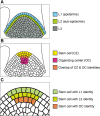Stem cells within the shoot apical meristem: identity, arrangement and communication
- PMID: 30523363
- PMCID: PMC11105333
- DOI: 10.1007/s00018-018-2980-z
Stem cells within the shoot apical meristem: identity, arrangement and communication
Abstract
Stem cells are specific cells that renew themselves and also provide daughter cells for organ formation. In plants, primary stem cell populations are nurtured within shoot and root apical meristems (SAM and RAM) for the production of aerial and underground parts, respectively. This review article summarizes recent progress on control of stem cells in the SAM from studies of the model plant Arabidopsis thaliana. To that end, a brief overview of the RAM is provided first to emphasize similarities and differences between the two apical meristems, which would help in better understanding of stem cells in the SAM. Subsequently, we will discuss in depth how stem cells are arranged in an organized manner in the SAM, how dynamically the stem cell identity is regulated, what factors participate in stem cell control, and how intercellular communication by mobile signals modulates stem cell behaviors within the SAM. Remaining questions and perspectives are also presented for future studies.
Keywords: Central zone; Organizing center; Peripheral zone; Shoot apical meristem; Stem cell; Tissue layer.
Figures




References
Publication types
MeSH terms
Substances
Grants and funding
LinkOut - more resources
Full Text Sources
Other Literature Sources
Medical

